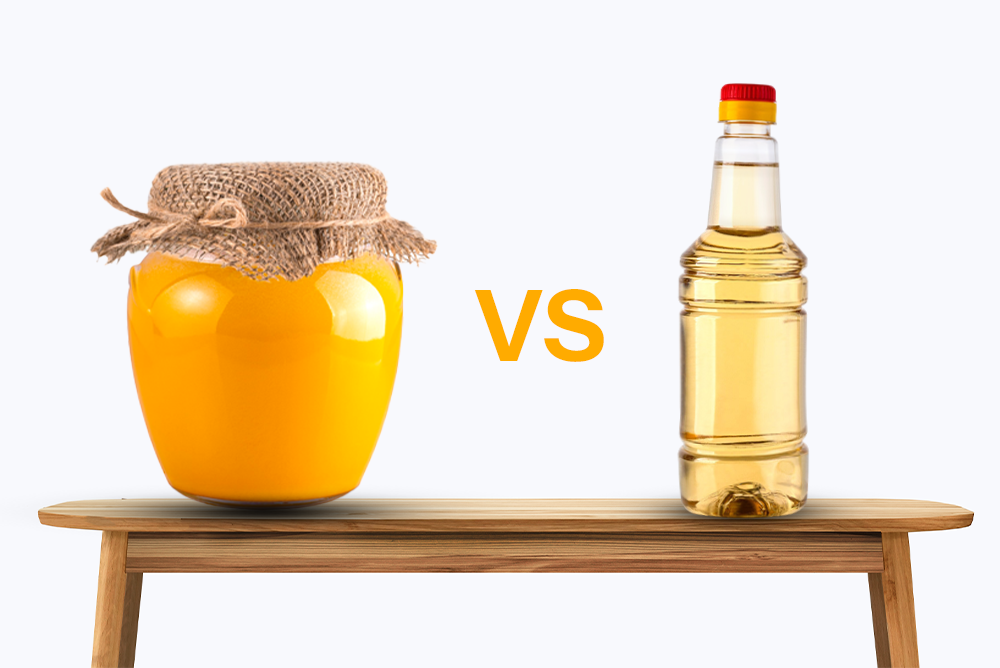In Indian kitchens, few debates are as flavorful as the one between pure ghee and vegetable oils. While ghee evokes nostalgia, tradition, and a rich aroma, oils have carved out a space for themselves with their variety and perceived lightness. So, when it comes to everyday cooking, how does one choose between the two?
Nutritional Profile: Ghee vs Common Vegetable Oils
Understanding the makeup of what goes into your food is always a good place to begin. Desi ghee clarified butter traditionally used in Indian households, contains saturated fats and fat-soluble vitamins like A, D, E, and K. Vegetable oils, on the other hand, vary significantly based on their source (sunflower, canola, soybean, rice bran, etc) and often contain unsaturated fats.
While some prefer the texture and taste ghee lends to dal, rotis, or desserts, others may opt for vegetable oils when preparing sautéed or fried dishes. It’s often less about which one is better and more about what aligns with your cooking needs and dietary choices.
Smoke Point and Cooking Suitability
The smoke point, the temperature at which oil begins to break down, can influence how an ingredient behaves in high-heat cooking. Many refined oils have high smoke points, making them a go-to choice for deep-frying or stir-frying.
However, pure ghee also offers a relatively high smoke point, especially compared to unrefined oils, which may make it more suitable for tempering or pan-frying in traditional Indian cooking. Depending on what you’re creating, be it sabzi, paratha, or tadka, the right fat can enhance both flavor and function.
Health Benefits of Desi Ghee
Ghee has long held a special place in Indian culinary traditions. Known for its rich aroma and taste, ghee is often added in small amounts to enhance the overall experience of food. It’s also been a key part of rituals, festive dishes, and even baby food in many Indian homes.
While modern diets often emphasize lighter cooking, desi ghee continues to be used thoughtfully in certain meals, perhaps a drizzle over steaming khichdi or a spoonful in festive sweets, not just for taste but also for its rooted presence in Indian traditions.
Brands like Sri Sri Tattva offer pure ghee that reflects this heritage, crafted with attention to quality and taste. It’s an option many consider when seeking ghee that suits both traditional recipes and modern-day preferences.
Concerns About Refined Oils
One aspect that has gained attention in recent years is the refining process of specific Indian cooking oil options. The method may involve high heat, chemical treatments, or the use of preservatives to ensure a longer shelf life and stability.
As a result, some home cooks have shifted toward oils that are less processed or toward traditional options such as cold-pressed oils or ghee. The preference often depends on awareness, cooking style, and the degree of control one wishes to have over ingredients.
Ayurvedic Perspective on Ghee
From an Ayurvedic viewpoint, ghee is regarded as a sattvic food, believed to support clarity, digestion, and nourishment when used in moderation. Ayurvedic texts often recommend ghee for agni (digestive fire) and use it as a base in various herbal formulations.
Of course, Ayurveda emphasizes personalized balance, so what suits one person might differ for another. Yet, the reverence for ghee in traditional Indian wellness practices has remained consistent across centuries.
When to Choose Ghee and When to Use Oil?
Ultimately, the question of ghee vs oil doesn’t need to be a contest. Each has its space in the Indian kitchen. For dishes steeped in tradition or those that require rich flavor, pure ghee may seem like a natural choice. For neutral flavors, sautéing, or calorie-conscious cooking, vegetable oils may be a better fit.
Balance is often key. Many households find harmony in using both ghee for its depth and legacy and oils for variety and technique.








